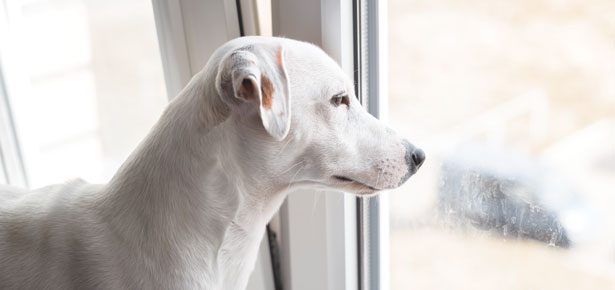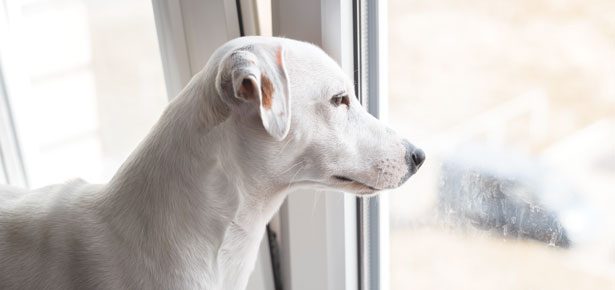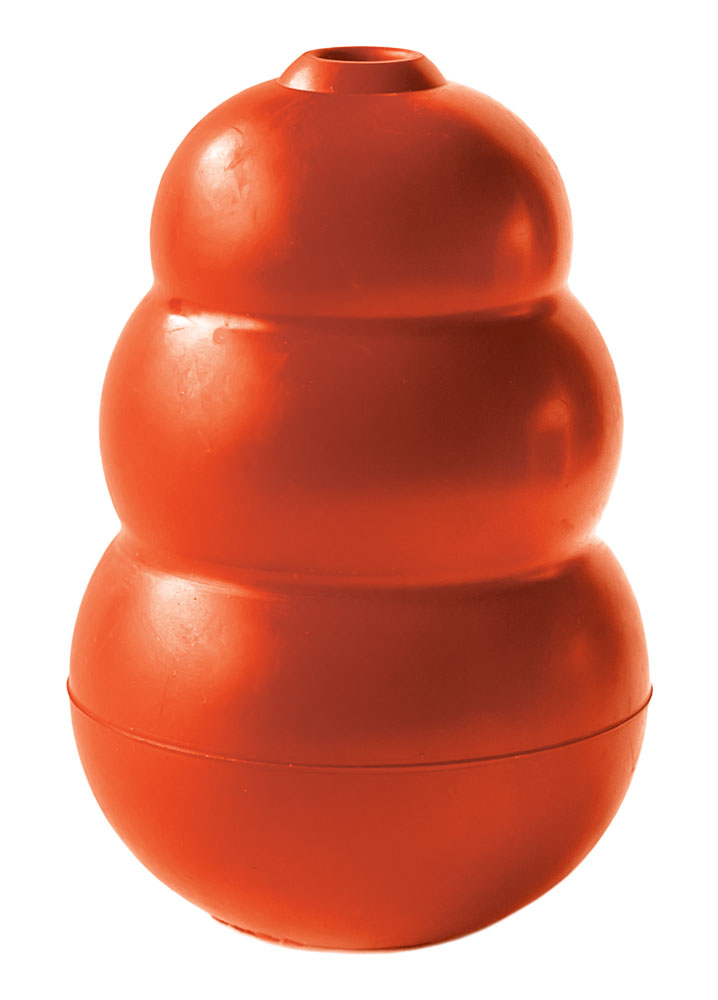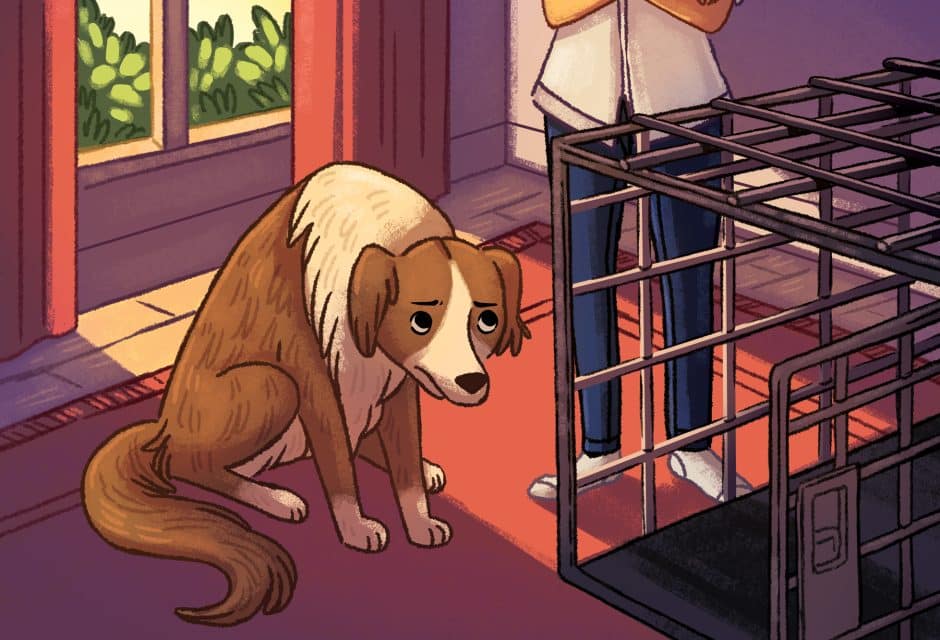

Dog Barks When Left Alone? Here’s What To Do
Why Your Dog Barks When You Leave & How to Stop It
Does your dog bark when you leave? You're not alone; this is a very common problem. We have expert advice from a dog behaviourist on what to do if your dog barks when left alone! Read on…
A reader recently wrote, “Help! My dog barks when I’m not at home, and my neighbours are losing patience. I need a solution, fast!”
To fix this problem of barking when home alone, we must first consider why your dog is barking.
Is something happening nearby (for example, construction) that could be triggering barking? Is your dog bored, under-stimulated or under-exercised?
Or, maybe your dog has separation anxiety. If you’re not sure, monitor him while you’re away. There are apps you can download that will allow you to monitor your dog. Just point your laptop's camera at your dog’s hangout area and then watch from your phone. Some will even alert you whenever your dog barks! (Two highly-rated apps available for both Apple and Android are “Barko” and “Dog Monitor & Pet Cam Watcher.”) Monitoring will tell you how much and how long your dog is barking, as opposed to accepting your neighbour’s subjective account. I once had a training client whose neighbour complained to animal control about her dog’s incessant barking. Upon monitoring the activity, we discovered the offender wasn’t even her dog, but the one next door!
“Upon monitoring the activity, we discovered the offender wasn’t even her dog, but the one next door!”
Outdoor noises triggering barking is less common than the other two reasons (boredom and separation anxiety), but if it is the case, confine your dog to an area away from the sounds with a white noise machine loud enough to screen it out. As for boredom, under-stimulation, being under-exercised or having separation anxiety, in all cases your dog will benefit from a long walk or hike in the morning before you leave. How long and how challenging the exercise should be depends on your dog’s age, fitness level, and breed, but the goal is for him to be pleasantly worn out. Next, think about where your dog will spend his alone time. Some dogs do better crated (up to three or four hours tops), some do better left loose, and some are more relaxed with indoor-outdoor access via a dog door. If your dog is destructive or has potty accidents, containment such as a crate or gate will be necessary.
Give your dog a stuffed Kong five to ten minutes before you depart. If he has separation anxiety, being immersed in a yummy excavation project should help him to focus on something other than you leaving. Even if the issue is simple boredom, the Kong will provide mental stimulation and help to discharge any remaining energy. The Kong could hold his morning meal (if you use dry kibble, add a bit of paté-consistency canned dog food to give it texture) and, if you plan ahead, you could even freeze it the night before so it lasts longer.

All of the foregoing is helpful whether your dog is bored or has separation anxiety or not. Addressing separation issues is complicated and would be a book in itself (I’ve actually written one called Don’t Leave Me), but here are a few tips:
Leave an item in your dog’s area that smells like you, such as a recently worn t-shirt.
- Keep your comings and goings low-key.
- Again, exercise your dog before you leave.
- Use pheromones. There is a product sold under the brand name Adaptil. It contains Dog Appeasing Pheromone, which mimics the pheromones given off by a lactating female dog. Turns out those pheromones are comforting not only to puppies, but to adult dogs as well. The product comes in an air-freshener type plug-in, a spray, or a collar. I prefer the plug-in (so long as you don’t have birds). Leave it plugged in; you won’t smell a thing. Will it work for every dog? No, because nothing does. But it’s definitely worth a try.
Calming music. I like “Through a Dog’s Ear: Volume 1” which is available as a CD or streaming through iCalmPet. The magic of this beautiful piano music, played by a concert pianist, was created in conjunction with an expert in psycho-acoustics to create a relaxation response in dogs. I have seen dogs go to sleep when hearing it, while others simply relax. Just be sure to play it at other times as well so it doesn’t become associated with your absences.
As mentioned, there is much more to treating separation anxiety. If separation anxiety turns out to be the underlying cause of your dog’s barking, consider enlisting the services of a professional trainer. You, your neighbour, and your dog will all be much happier.
Bottom inset photos: Kong image by Nature Art/shutterstock.com, t-shirt image by sumnersgraphicsinc/bigstock.com, CD image by llepod/bigstock.com
Join the newsletter and never miss out on dog content again!
"*" indicates required fields
By clicking the arrow, you agree to our web Terms of Use and Privacy & Cookie Policy. Easy unsubscribe links are provided in every email.
 Leave an item in your dog’s area that smells like you, such as a recently worn t-shirt.
Leave an item in your dog’s area that smells like you, such as a recently worn t-shirt. Calming music. I like “Through a Dog’s Ear: Volume 1” which is available as a CD or streaming through iCalmPet. The magic of this beautiful piano music, played by a concert pianist, was created in conjunction with an expert in psycho-acoustics to create a relaxation response in dogs. I have seen dogs go to sleep when hearing it, while others simply relax. Just be sure to play it at other times as well so it doesn’t become associated with your absences.
Calming music. I like “Through a Dog’s Ear: Volume 1” which is available as a CD or streaming through iCalmPet. The magic of this beautiful piano music, played by a concert pianist, was created in conjunction with an expert in psycho-acoustics to create a relaxation response in dogs. I have seen dogs go to sleep when hearing it, while others simply relax. Just be sure to play it at other times as well so it doesn’t become associated with your absences.




